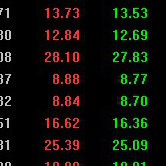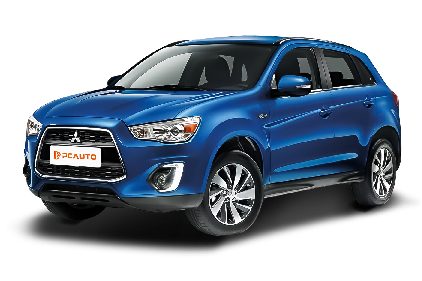Q
How to use cruise control of Mitsubishi ASX?
The Mitsubishi ASX doesn't come with a cruise control function. However, if the vehicle has it installed later or is already equipped with this feature, the general usage steps are as follows. First, press the "ON/OFF" or "CRUISE" main cruise control switch. At this time, the cruise control indicator on the dashboard will light up, and the system will enter the standby state. Then, accelerate the vehicle to the speed you want to set, and the vehicle speed needs to be above 30 km/h. Then press the "SET" button and release the right - foot accelerator. The vehicle will then drive at a constant speed at the current speed.
During the cruise, if you want to slightly tune the speed, you can press the "+" or "ACCEL" button to speed up, and press the "-" or "COAST" button to slow down. If you want to pause the cruise, you can press the "CANCEL" button or gently tap the brake. Later, if you want to resume the previously set cruise speed, just press the "RES" button.
However, it should be noted that cruise control cannot replace the driver's constant attention to the road conditions. It is not recommended to use it in complex road conditions or bad weather, and appropriate braking assistance or turning off the function is necessary on downhill roads.
Special Disclaimer: This content is published by users and does not represent the views or position of PCauto.
Related Q&A
Q
What tyre pressure for 2018 Mitsubishi ASX?
The recommended standard tire pressure for the 2018 Mitsubishi ASX usually ranges from 32 to 35 psi (pounds per square inch). The specific value may vary slightly depending on the vehicle configuration, tire size, or load. Owners can refer to the vehicle's user manual or the label on the driver's door frame to get accurate information.
In Malaysia's tropical climate, tire pressure will rise slightly due to high temperatures. Therefore, it is recommended to check and adjust the tire pressure in the morning or when the tires are cool to ensure driving safety and fuel efficiency. Proper tire pressure can not only extend the tire life but also improve the vehicle's handling and comfort. On the contrary, too high or too low tire pressure may lead to uneven tire wear, reduced grip, and even the risk of tire blow - out.
If you often drive long - distance or carry heavy loads, you can consider slightly increasing the rear tire pressure to the upper limit of the recommended range, but avoid exceeding the maximum pressure rating marked on the tire. Regularly checking tire pressure is an important part of vehicle maintenance. It is recommended to check at least once a month and use a reliable tire pressure gauge or the professional equipment at gas stations for measurement.
Q
Is the 2018 Mitsubishi ASX a 4x4?
The 2018 Mitsubishi ASX available in the Malaysian market doesn't come standard with a four - wheel drive (4x4) system. Instead, it mainly features front - wheel drive (FWD), which is different from the 4WD versions offered in some overseas markets. As a compact SUV, the ASX focuses on fuel economy and practicality for city driving. Its power combination of a 2.0 - liter MIVEC engine paired with a CVT transmission is more suitable for daily commuting. If you need the 4x4 function, you can consider other Mitsubishi models like the Triton pickup or the Pajero Sport, which are designed for off - road use and are more popular in the local market.
It's worth noting that Malaysian consumers usually pay more attention to on - road performance and cost - effectiveness when choosing an SUV. The positioning of the ASX exactly meets this demand, and its low maintenance cost and reliable quality are also the reasons for its popularity. For users who occasionally need light off - road driving, it's recommended to focus on the vehicle's ground clearance (the ASX has about 195mm) and electronic assistance systems, rather than insisting on a four - wheel drive configuration. After all, the 4x4 systems of most city SUVs are used less frequently and will increase the purchase and maintenance costs.
Q
Does the 2018 Mitsubishi ASX have a 360 camera?
The 2018 Mitsubishi ASX didn't come standard with a 360 - degree panoramic camera in the Malaysian market. At that time, the model mainly offered a reversing camera as an auxiliary driving configuration. The more advanced 360 - degree surround - view imaging system usually appeared in the top - of - the - line versions or subsequent facelifted models. If car owners wish to upgrade this function, they can install it through the original manufacturer or third - party certified modification plans, but they need to pay attention to compatibility and warranty terms.
The 360 - degree camera achieves all - round monitoring through multi - lens splicing technology, which is especially useful for parking in narrow roads or off - road scenarios. In recent years, it has become a popular configuration for SUVs in the Malaysian market. For example, models like the Proton X90 and Toyota Corolla Cross both offer similar functions.
It is recommended that consumers confirm the original factory configuration list with authorized dealers via the VIN code before purchasing a used car or making modifications, or refer to the automotive specification manuals recognized by MITI to obtain accurate information. The popularity of such driving - assistance technologies also reflects the increasing demand for driving safety among Malaysian consumers. Additionally, it is advisable to regularly clean the camera lenses to ensure clear imaging.
Q
Does the 2018 ASX have Apple CarPlay?
Some models of the 2018 Mitsubishi ASX in the Malaysian market are indeed equipped with the Apple CarPlay function. However, it specifically depends on the vehicle's configuration level. It is recommended that car owners check the original factory specification sheet or directly contact Mitsubishi's Malaysian dealers to confirm whether their vehicles support this function, as there may be differences in configurations across different regions. As an intelligent in-vehicle system, Apple CarPlay can connect to an iPhone via USB to enable functions such as navigation, music playback, and making calls, significantly enhancing driving convenience. It should be noted that if your ASX does not come pre-installed with this function, you can later achieve it by upgrading the head unit or installing an additional module. However, it is essential to choose an officially certified modification plan to ensure compatibility and driving safety. Other SUVs in the same class, such as the Honda HR - V or the Mazda CX - 3, also gradually popularized smartphone connectivity functions around the same time, which reflects the trend of automotive technology towards intelligent development. In Malaysia's hot and rainy climate, when using CarPlay, it is advisable to keep your phone and the in-vehicle system updated to the latest versions to avoid device malfunctions caused by high temperatures. Additionally, the anti-glare design of the original factory screen can also improve operational safety under the scorching sun.
Q
What are the features of the Mitsubishi ASX 2018?
The 2018 Mitsubishi ASX is a highly - regarded compact SUV in the Malaysian market. Its main features include a stylish exterior design. It adopts Mitsubishi's family - style Dynamic Shield front face, paired with LED daytime running lights and 18 - inch wheels. The overall shape is both dynamic and practical.
In terms of the interior, the 2018 ASX is equipped with a 7 - inch touchscreen infotainment system that supports Apple CarPlay and Android Auto, making it convenient for users to connect their smartphones. It also offers a reverse camera and a multifunctional steering wheel to enhance driving convenience.
Regarding power, it is powered by a 2.0 - liter MIVEC four - cylinder gasoline engine with a maximum output of 150 horsepower. Matched with a CVT transmission, it provides a smooth driving experience. There are both front - wheel drive and four - wheel drive versions available, which are suitable for urban commuting and light off - road needs.
In terms of safety configuration, the 2018 ASX comes standard with 7 airbags, ABS, EBD, and a vehicle stability control system to meet daily safety requirements. For Malaysian consumers, the 2018 ASX also has relatively economical fuel consumption, making it suitable for family use. Meanwhile, its high ground clearance and reliable suspension system can adapt to the diverse local road conditions.
It's worth mentioning that Mitsubishi ASX has a well - established after - sales service network in the Malaysian market, providing additional assurance for car owners. This vehicle offers outstanding cost - effectiveness among its peers, making it suitable for consumers with a limited budget who still pursue practicality and brand reliability.
Q
What is the fuel consumption of a 2018 Mitsubishi ASX?
The fuel consumption of the 2018 Mitsubishi ASX varies depending on the specific model and driving conditions. According to official data, the version with a 2.0-liter naturally aspirated engine paired with a CVT transmission consumes about 8.5 - 9.2 liters per 100 kilometers in city driving conditions. When driving on the highway, it can drop to 6.3 - 6.8 liters per 100 kilometers, and the combined fuel consumption is approximately 7.2 - 7.6 liters per 100 kilometers. The actual fuel consumption is also affected by driving habits, road conditions, and the vehicle's maintenance status.
For users in Malaysia, considering the hot local climate and frequent traffic congestion, it is recommended to have the vehicle regularly maintained and keep the tire pressure at an appropriate level to ensure fuel efficiency. In addition, using the air - conditioning system reasonably and avoiding sudden acceleration and braking can also effectively reduce fuel consumption.
As a compact SUV, the Mitsubishi ASX is popular in the Malaysian market for its reliability and practicality. It is suitable for daily family use and long - distance travel. If you have higher requirements for fuel consumption, you can consider hybrid or pure - electric models. However, with the infrastructure support in Malaysia, traditional fuel - powered vehicles are still a convenient choice.
Q
How much power does a 2018 Mitsubishi ASX have?
The 2018 Mitsubishi ASX's powertrain configurations available in the Malaysian market vary by version. It is equipped with a 2.0-liter MIVEC naturally aspirated gasoline engine, with a maximum output power of 150 horsepower (110 kilowatts) and a peak torque of 197 Newton-meters. It is mated to a 5-speed manual or a CVT continuously variable transmission, and its power performance is suitable for urban driving and light off-road needs. This compact SUV continues Mitsubishi's tradition of durability. The chassis tuning balances comfort and stability, and its fuel economy meets the needs of Southeast Asian users.
It's worth mentioning that the exclusive Mitsubishi MIVEC variable valve timing technology used in the ASX can optimize power output and fuel consumption at different speeds. Meanwhile, Japanese competitors in the same class, such as the Honda HR-V or the Toyota C-HR, tend to have a more sporty tuning style, allowing consumers to choose according to their driving preferences.
In Malaysia's hot and rainy climate, it is recommended to regularly check the condition of the CVT transmission fluid to ensure long-term stable performance. Additionally, the five-year warranty policy provided by the manufacturer can offer extra protection for car owners.
Q
What size engine is in the 2018 Mitsubishi ASX?
The 2018 Mitsubishi ASX offers two gasoline engine options in the Malaysian market, namely the 1.6-liter and 2.0-liter MIVEC naturally aspirated engines. The 1.6-liter engine (model 4A92) can output 114 horsepower and 149 Nm of torque, while the 2.0-liter engine (model 4B11) provides 150 horsepower and 197 Nm of torque. Both are paired with the INVECS-III continuously variable transmission (CVT). This powertrain configuration balances the smoothness of daily driving and fuel economy.
It's worth mentioning that the MIVEC technology intelligently adjusts the valve timing and lift, optimizing the power output and fuel consumption at different engine speeds. It's very suitable for the usage scenarios in Malaysia, including city driving and occasional long - distance travels.
As a compact SUV from Mitsubishi, the engine displacement of the ASX is at the mainstream level among its peers. For example, the Honda HR - V also offers a 1.8 - liter engine option, while the Mazda CX - 3 uses a 2.0 - liter engine. Consumers can make a choice based on their own power requirements and road tax budget (in Malaysia, the higher the engine displacement, the higher the road tax).
In addition, the maintenance cost of the ASX is relatively affordable, and there is an abundant supply of local parts. This is also one of the factors considered by many Malaysian car owners.
Q
How much oil does a 2018 Mitsubishi ASX engine take?
The engine oil capacity of the 2018 Mitsubishi ASX varies depending on the engine model. The version equipped with the 1.6-liter 4A92 engine usually requires about 3.7 liters of oil (including the capacity when replacing the oil filter), while the version with the 2.0-liter 4B11 engine needs about 4.3 liters of oil. It is recommended to use 5W - 30 or 10W - 30 viscosity oil that meets the original factory specifications to ensure optimal performance.
In the hot and humid climate of Malaysia, regular oil changes are particularly important. Generally, it is recommended to change the oil every 5,000 to 10,000 kilometers or every 6 months. The specific interval can refer to the owner's manual or the advice of an authorized service center.
It should be noted that when changing the oil, the oil filter should be replaced at the same time, and the oil level should be between the MIN and MAX marks on the dipstick. Excessive or insufficient oil may affect the engine's lifespan. In addition, choosing synthetic oil with API SN or higher certification can provide better high - temperature protection performance, which is especially suitable for the high - temperature driving environment in Malaysia.
If you're not sure about the exact oil capacity of your vehicle, the safest way is to check the vehicle manual or consult a Mitsubishi authorized service center. They can offer professional advice based on your vehicle configuration.
Q
Is the 2018 Mitsubishi ASX AWD or 4WD?
The 2018 Mitsubishi ASX is available in two drivetrain versions in the Malaysian market: Front-Wheel Drive (FWD) and Four-Wheel Drive (4WD). However, it doesn't come with an All-Wheel Drive (AWD) system. The 4WD system of the ASX is a part-time four-wheel drive. Usually, it automatically distributes power to the rear wheels only when the front wheels start to slip. It's suitable for occasional encounters with slippery roads or light off-road situations, which is more than enough for Malaysia's rainy climate and urban commuting.
It's worth noting that the main difference between AWD and 4WD is that AWD is typically full-time and doesn't require manual switching, while 4WD is often used in off-road vehicles and may have a transfer case. Mitsubishi's 4WD system is well - known for its reliability and practicality. As a compact SUV, the 4WD version of the ASX strikes a good balance between fuel economy and passability. It's a great fit for Malaysian users who occasionally need to handle rough roads but don't want to sacrifice their daily driving comfort.
Latest Q&A
Q
How much is the 2024 Crown XLE?
The official price of the 2024 Toyota Crown XLE currently ranges from approximately RM250,000 to RM300,000, with the exact figure potentially varying based on optional configurations, dealer discounts, or promotional activities. This model is equipped with a 2.5-liter hybrid system that delivers a combined 234 horsepower, paired with an electronic all-wheel-drive system. It achieves a fuel consumption of around 5.6L/100km, balancing performance and fuel efficiency nicely. Standard features include a 12.3-inch infotainment screen, Toyota Safety Sense 3.0, a panoramic sunroof, and leather seats, among other premium touches. Notably, as Toyota's flagship sedan, the 2024 Crown rides on the new TNGA-K platform, which enhances body rigidity while lowering the center of gravity, resulting in noticeably improved handling stability compared to its predecessor. When considering competitors in the same class, you might compare it to hybrid versions of the Honda Accord or Nissan Teana, but the Crown XLE holds an edge in terms of sound insulation and rear passenger space. It's advisable to visit an authorized dealership for a test drive before purchasing to experience the suspension tuning and the hybrid system's smoothness firsthand, and keep an eye out for possible special offers during year-end auto shows.
Q
Is the Toyota Crown 2024 electric or gas?
The 2024 Toyota Crown currently offers a variety of powertrain options, including traditional gasoline versions and hybrid versions, but there's no pure electric variant available yet. The gasoline models come with either a 2.5-liter four-cylinder engine or a 3.5-liter V6, while the hybrid pairs a 2.5-liter engine with an electric motor, balancing fuel efficiency and performance. Design-wise, this car blends elements of a sporty coupe and a luxury sedan, packing advanced driver assistance systems and tech features like a full digital instrument cluster and a large infotainment screen. Even though there's no pure EV option right now, Toyota is ramping up its electrification efforts globally, so we might see more new energy models down the line. For eco-conscious buyers, the hybrid is a solid pick—it delivers better overall fuel economy than traditional gas-powered cars, and you don't have to stress about charging infrastructure. The Crown lineup has always been known for comfort and reliability, and the 2024 model carries on that tradition while stepping up interior quality and sound insulation. If you're set on a pure electric vehicle, keep an eye on Toyota's bZ series or check out EVs from other brands—there are already plenty of choices in the local market.
Q
Where is the 2024 Toyota Crown made?
The 2024 Toyota Crown is primarily built at Toyota's Motomachi Plant in Japan, a facility renowned for crafting premium models and prioritizing craftsmanship. This car rides on Toyota's latest TNGA-K platform, striking a balance between handling stability and ride comfort. Under the hood, you've got two choices: a 2.5-liter hybrid and a 2.4-liter turbocharged hybrid. The latter comes with the DIRECT4 electronic all-wheel-drive system, which smartly distributes torque to enhance cornering performance. It's worth noting that as Toyota's flagship model, the Crown's hybrid system has been specially tuned to deliver more immediate power response while keeping fuel consumption low. Local buyers might notice it leans more into sporty styling than traditional Toyotas, with things like the sloping roofline and 21-inch wheels, yet the interior remains spacious, with rear legroom that's top-notch for its class. On the after-sales front, Toyota offers an 8-year/200,000-kilometer warranty for the hybrid battery and a 5-year/100,000-kilometer warranty for the powertrain, so you can drive with peace of mind. Even though it's positioned as a premium offering, maintenance costs aren't drastically different from regular Toyotas, with routine service recommended every 10,000 kilometers or 6 months.
Q
How much does a 2024 Toyota Crown Platinum cost?
The 2024 Toyota Crown Platinum, as the flagship model, is expected to be priced between RM 350,000 and RM 400,000, depending on optional configurations and dealer promotions. It's powered by a 2.4-liter turbocharged hybrid system with a combined output of 340 horsepower, paired with an electronic all-wheel-drive system, delivering impressive performance and fuel efficiency. Inside, you'll find premium leather seats, a 12.3-inch digital instrument cluster, and a head-up display, packing plenty of tech appeal. On the safety front, it comes standard with Toyota Safety Sense 3.0, which includes pre-collision warning and full-speed adaptive cruise control. Positioned between luxury and sportiness, the Crown Platinum prioritizes comfort more than its German rivals in the same price bracket, while offering better value for money compared to Lexus models. Recent fluctuations in the Japanese yen exchange rate might affect the final selling price, so it's advisable to compare packages from different dealers before making a purchase—some dealerships may even offer perks like free maintenance or low-interest financing.
Q
What is the difference between 2024 and 2025 Toyota Crown?
The main differences between the 2024 and 2025 Toyota Crown lie in exterior details, equipment upgrades, and powertrain refinements. The 2025 model likely gets sharper lines and updated LED lighting up front, while interior materials and tech get a boost too—think a bigger infotainment screen or the latest multimedia system. Under the hood, the 2025 Crown probably sees improved hybrid efficiency for better fuel economy, and some markets might even get new powertrain options. For fans of the model, the 2025 updates are more about tweaking details and enhancing the user experience rather than a full redesign. So if you're watching your budget, the 2024 version still holds up as a solid pick. With its long history, the Toyota Crown has always been known for comfort and reliability, and the new model keeps that tradition alive—perfect for buyers who value quality and practicality.
View MoreRelated News

Mitsubishi Lancer Evolution might be resurrected, so what will the new Evo look like?
WilliamNov 14, 2025

Choose Honda HR-V or Mitsubishi XPANDER for a family car?
WilliamNov 12, 2025

Toyota HiAce and Mitsubishi Outlander upgraded to receive five-star safety rating
WilliamSep 24, 2025

Mitsubishi Cuts Full-Year Profit Forecast by 30%, Challenged by US Tariffs and Intensified Global Competition
Kevin WongAug 28, 2025

Mitsubishi to Launch Electric Vehicle Based on Nissan Leaf in Second Half of 2026
LienMay 8, 2025
View More















Pros
Cons